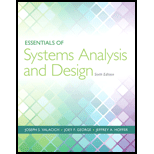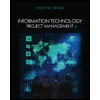
Pearson eText for Essentials of Systems Analysis and Design -- Instant Access (Pearson+)
6th Edition
ISBN: 9780137612420
Author: Joseph Valacich, Joey George
Publisher: PEARSON+
expand_more
expand_more
format_list_bulleted
Concept explainers
Expert Solution & Answer
Chapter 3, Problem 18M
Program Description Answer
Program Evaluation and Review Technique (PERT) is a method used to calculate the expected time for a particular task using optimistic, pessimistic, and realistic time estimates.
Hence, correct answer is “PERT”.
Expert Solution & Answer
Want to see the full answer?
Check out a sample textbook solution
Students have asked these similar questions
A business case scenario and asked to formulate an appropriate software design solution. Theyshould complete the case and upload the solution. will be required to read the case,identify and document the key issues, problems, and opportunities presented, and then design,and develop an appropriate integrated design solution to the problem. mustdemonstrate good spreadsheet, database, analytical, and word-processing skills whendeveloping solutions. Additionally, must be creative and demonstrate synthesising andapplying Database Management and Data Analytics Principles learned in the course. They willalso need to research some aspects of the assessment.
CASE BACKGROUNDMGMT SS STATS, an umbrella body that facilitates and serves various Social SecurityOrganizations/Departments within the Caribbean territories, stoodpoised to meet the needs of its stakeholders by launching an onlinedatabase at www.SSDCI.gov. The database will provide membersand the public access to the complete set of…
Using MATLAB symbolic toolbox, given these 3 equations, how would you solve for mu = function(theta), making sure that there are no mu's on the right hand side, making sure theta-dot-dot, theta-dot-squared- and N aren't in the final answer either.
After playing our giving implementation, your task is to implement Dinning Philosophers
with semaphore in C, by including and
Your implementation will require creating five philosophers, each identified by a number
0.4. Each philosopher will run as a separate thread. Create threads using Pthreads
as discussed in the Lecture slides on Chapter 4 and Practice Lab on Threads.
Your solution needs to accomplish the following:
Implement in C (15 points)
1. dp1.c - You are to provide your solution to this assignment as a single C program
named 'dp1.c using semaphore. Explain in you code (as comments) that the dead
lock will happen or not. If there is a possible deadlock, you can simply solve the
deadlock by pick the fork in order like the first solution in our slides.
Solve Deadlock by Footman (15 points)
1. Here is a new solution to overcome the deadlock. The Dining Philosophers decide to
hire a footman whose task to allow only four philosophers to sit on the table. When
entering and…
Chapter 3 Solutions
Pearson eText for Essentials of Systems Analysis and Design -- Instant Access (Pearson+)
Ch. 3 - An online or hard-copy repository for all project...Ch. 3 - Prob. 2MCh. 3 - Prob. 3MCh. 3 - Prob. 4MCh. 3 - Prob. 5MCh. 3 - Prob. 6MCh. 3 - Prob. 7MCh. 3 - Prob. 8MCh. 3 - Prob. 9MCh. 3 - The process of dividing the project into...
Ch. 3 - Prob. 11MCh. 3 - A graphical representation of a project that shows...Ch. 3 - Prob. 13MCh. 3 - Prob. 14MCh. 3 - A systems analyst with a diverse set of...Ch. 3 - The second phase of the project management...Ch. 3 - Prob. 17MCh. 3 - Prob. 18MCh. 3 - Prob. 19MCh. 3 - Prob. 20MCh. 3 - Prob. 1RQCh. 3 - Prob. 2RQCh. 3 - Prob. 3RQCh. 3 - Prob. 4RQCh. 3 - Prob. 5RQCh. 3 - Prob. 6RQCh. 3 - Prob. 7RQCh. 3 - Prob. 8RQCh. 3 - Prob. 9RQCh. 3 - Describe the steps involved in making a network...Ch. 3 - In which phase of the systems development life...Ch. 3 - What are some reasons why one activity may have to...Ch. 3 - Which of the four phases of the project management...Ch. 3 - What are some sources of risk in a systems...Ch. 3 - Search the Web for recent reviews of project...Ch. 3 - Prob. 16PECh. 3 - Prob. 17PECh. 3 - Prob. 18PECh. 3 - Prob. 19PECh. 3 - Construct a Gantt chart for the project defined in...Ch. 3 - Look again at the activities outlined in Problem...Ch. 3 - Prob. 25PECh. 3 - Prob. 26PECh. 3 - Prob. 27PECh. 3 - Prob. 29PECh. 3 - Prob. 30PECh. 3 - Prob. 31PECh. 3 - Prob. 32PECh. 3 - Prob. 33DQCh. 3 - Do you agree that breaking projects down into...Ch. 3 - Microsoft Project is powerful but expensive....Ch. 3 - When completing a project, some tasks are...Ch. 3 - a. While eating lunch one day, Juanita asked Chris...Ch. 3 - What qualities might Jim possess that would make...Ch. 3 - Prob. 41CQCh. 3 - Prob. 42CQCh. 3 - What should Jim do next to complete the project...Ch. 3 - Prob. 44CQ
Knowledge Booster
Learn more about
Need a deep-dive on the concept behind this application? Look no further. Learn more about this topic, computer-science and related others by exploring similar questions and additional content below.Similar questions
- 8.4 Self-Bias Configuration 20. Determine Zi. Zo. and A,, for the network of Fig. 8.73 if gf, = 3000 μS and gos = 50 μs. 21. Determine Z, Zo, and A, for the network of Fig. 8.73 if the 20-uF capacitor is removed and the parameters of the network are the same as in Problem 20. Compare results with those of Problem 20. +12 V 3.3 ΚΩ HE C₂ Vo Z Zo C₁ 10 ΜΩ Z₁ 1.1 ΚΩ Cs 20 µF FIG. 8.73 Problems 20, 21, 22, and 59.arrow_forward21. Determine Zi, Zo, and A, for the network of Fig. 8.73 if the 20-μF capacitor is removed and the parameters of the network are the same as in Problem 20. Compare results with those of Problem 20. +12 V 3.3 ΚΩ +6 C₂ C₁ Z₁ 10 ΜΩ 1.1 ΚΩ Cs 20 μF FIG. 8.73 Zoarrow_forwardNinth Edition Determine Zi, Zo and Av 20 V Zi + 1 ΜΩ 2 ΚΩ HH Z IDSS= 6MA Vp=-6V Yos = 40μS 20 and 47arrow_forward
- What is the worst case time complexity of the following algorithm for i = 1 to x do for j = 2^((i-1)x) to 2^(in) do print(i,j)arrow_forwardProve for each pair of expression f(n) and g(n) whether f(n) is big O, little o Ω,ω or Θ of g(n). For each case it is possible that more than one of these conditions is satisfied:1. f(n) =log(n2^n), g(n) = log(sqrt(n)2^(n^2))2. f(n) =nsqrt(n) +log(n^n), g(n) =n + sqrt(n)lognarrow_forwardI need to make a parallel version of this sequential codearrow_forward
- I need to make a parallel version of this sequential code.arrow_forwardBenefits of using arrays as instance variables: What are the advantages of incorporating arrays as instance variables within a class? Initializing and managing arrays: How do you initialize and manage arrays within class constructors and mutators (setters)? Example of using arrays as instance variables: Share an example where you have used arrays as instance variables and discuss its application in a real-world scenario. Common mistakes with arrays as instance variables: What are some common mistakes to avoid when working with arrays as instance variables? Information hiding violations: What is the potential violation of information hiding when using arrays as instance variables? How can this be resolved?arrow_forwardDo you think that computers should replace teachers? Give three references with your answer.arrow_forward
- Is online learning or face to face learning better to teach students around the around the world? Give reasons for your answer and provide two references with your response. What are benefits of both online learning and face to face learning ? Give two references with your answer. How does online learning and face to face learning affects students around the world? Give two references with your answer.arrow_forwardExplain Five reasons if computers should replace teachers. Provide three references with your answer. List three advantages and three disadvantages face to face learning and online learning may have on children. Provide two references with your answer.arrow_forwardYou were requested to design IP addresses for the following network using the address block 10.10.10.0/24. Specify an address and net mask for each network and router interfacearrow_forward
arrow_back_ios
SEE MORE QUESTIONS
arrow_forward_ios
Recommended textbooks for you
 Principles of Information Systems (MindTap Course...Computer ScienceISBN:9781305971776Author:Ralph Stair, George ReynoldsPublisher:Cengage Learning
Principles of Information Systems (MindTap Course...Computer ScienceISBN:9781305971776Author:Ralph Stair, George ReynoldsPublisher:Cengage Learning Enhanced Discovering Computers 2017 (Shelly Cashm...Computer ScienceISBN:9781305657458Author:Misty E. Vermaat, Susan L. Sebok, Steven M. Freund, Mark Frydenberg, Jennifer T. CampbellPublisher:Cengage Learning
Enhanced Discovering Computers 2017 (Shelly Cashm...Computer ScienceISBN:9781305657458Author:Misty E. Vermaat, Susan L. Sebok, Steven M. Freund, Mark Frydenberg, Jennifer T. CampbellPublisher:Cengage Learning Information Technology Project ManagementComputer ScienceISBN:9781337101356Author:Kathy SchwalbePublisher:Cengage Learning
Information Technology Project ManagementComputer ScienceISBN:9781337101356Author:Kathy SchwalbePublisher:Cengage Learning Information Technology Project ManagementComputer ScienceISBN:9781285452340Author:Kathy SchwalbePublisher:Cengage Learning
Information Technology Project ManagementComputer ScienceISBN:9781285452340Author:Kathy SchwalbePublisher:Cengage Learning Principles of Information Security (MindTap Cours...Computer ScienceISBN:9781337102063Author:Michael E. Whitman, Herbert J. MattordPublisher:Cengage Learning
Principles of Information Security (MindTap Cours...Computer ScienceISBN:9781337102063Author:Michael E. Whitman, Herbert J. MattordPublisher:Cengage Learning Fundamentals of Information SystemsComputer ScienceISBN:9781337097536Author:Ralph Stair, George ReynoldsPublisher:Cengage Learning
Fundamentals of Information SystemsComputer ScienceISBN:9781337097536Author:Ralph Stair, George ReynoldsPublisher:Cengage Learning

Principles of Information Systems (MindTap Course...
Computer Science
ISBN:9781305971776
Author:Ralph Stair, George Reynolds
Publisher:Cengage Learning

Enhanced Discovering Computers 2017 (Shelly Cashm...
Computer Science
ISBN:9781305657458
Author:Misty E. Vermaat, Susan L. Sebok, Steven M. Freund, Mark Frydenberg, Jennifer T. Campbell
Publisher:Cengage Learning

Information Technology Project Management
Computer Science
ISBN:9781337101356
Author:Kathy Schwalbe
Publisher:Cengage Learning

Information Technology Project Management
Computer Science
ISBN:9781285452340
Author:Kathy Schwalbe
Publisher:Cengage Learning

Principles of Information Security (MindTap Cours...
Computer Science
ISBN:9781337102063
Author:Michael E. Whitman, Herbert J. Mattord
Publisher:Cengage Learning

Fundamentals of Information Systems
Computer Science
ISBN:9781337097536
Author:Ralph Stair, George Reynolds
Publisher:Cengage Learning